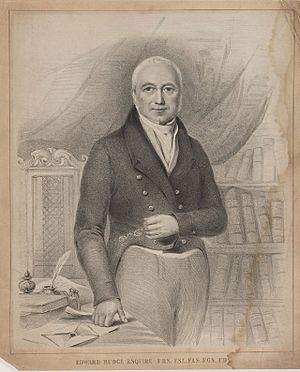Edward Rudge facts for kids
Edward Rudge (born June 27, 1763 – died September 3, 1846) was an English botanist and someone who studied old things, known as an antiquary. He was very interested in plants and history.
Life
Edward Rudge grew up in a family connected to Salisbury. His father was a merchant and an alderman, which is like a city council member. His family owned a big part of the old Evesham Abbey land.
Edward went to Queen's College, Oxford, in 1781, but he didn't finish his degree there. He became interested in plants, or botany, thanks to his uncle, Samuel Rudge. His uncle had a large collection of dried plants, called an herbarium, which Edward later inherited.
This interest in plants grew even more when Edward bought a special collection of plants from The Guianas (a region in South America). These plants had been collected by Joseph Martin. Edward then decided to study the plants from that country. Between 1805 and 1807, he published a book called Plantarum Guianæ rariorum icones et descriptiones hactenus ineditæ. This book had pictures and descriptions of rare plants from the Guianas that hadn't been seen before.
Edward Rudge also loved history. From 1811 to 1834, he led excavations (digs) on his land at Evesham Abbey. He found many old ruins and artifacts. He shared his discoveries with the Society of Antiquaries of London, a group that studies old things. They even showed pictures of his findings in their old books.
In 1842, Edward built an octagon-shaped tower on the battlefield of Evesham. This tower was built to remember Simon de Montfort, 6th Earl of Leicester, an important historical figure.
Edward Rudge was a member of several important groups. He became a fellow of the Society of Antiquaries of London, the Linnean Society (which focuses on natural history) in 1802, and the Royal Society (a famous scientific group) in 1805. In 1829, he was also chosen to be the High Sheriff of Worcestershire, a special official who helped with legal matters in the county.
He passed away at his home, the Abbey Manor House in Evesham, on September 3, 1846. Edward was married twice, and one of his wives was the botanist Anne Rudge. To honor his work, a type of plant from the family Rubiaceae was named Rudgea after him in 1806.
Edward Rudge's son, Edward John Rudge (1792–1861), also became a scholar. He was a lawyer and a fellow of the Society of Antiquaries. He wrote books about the history of Evesham and Buckden Palace.
Work
Besides his big book on plants from the Guianas, Edward Rudge wrote several scientific papers. He published about seven botanical papers in the journals of the Royal and Linnean societies. He also wrote several papers for Archæologia, a publication from the Society of Antiquaries. One of his papers described seven new types of plants found in New Holland (which is now Australia).


